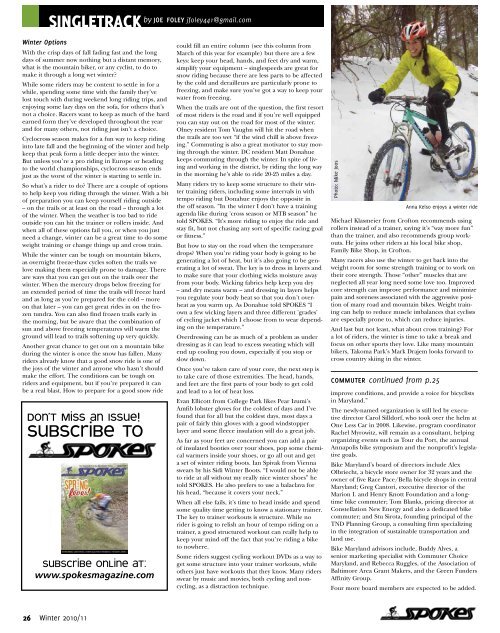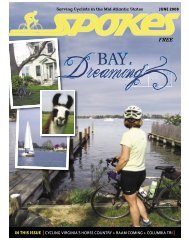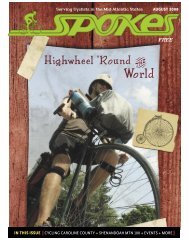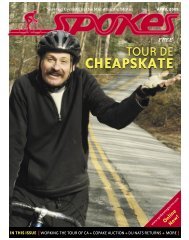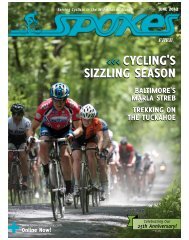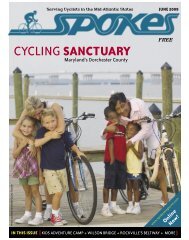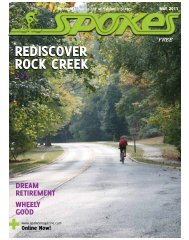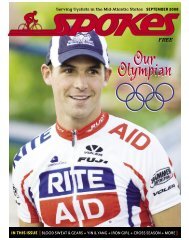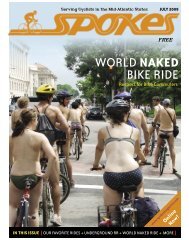it ALL StArtS At 40 it ALL StArtS At 40 - Spokes Magazine
it ALL StArtS At 40 it ALL StArtS At 40 - Spokes Magazine
it ALL StArtS At 40 it ALL StArtS At 40 - Spokes Magazine
Create successful ePaper yourself
Turn your PDF publications into a flip-book with our unique Google optimized e-Paper software.
singletrack<br />
by joe foley jfoley441@gmail.com<br />
improve<br />
Winter Options<br />
W<strong>it</strong>h the crisp days of fall fading fast and the long<br />
days of summer now nothing but a distant memory,<br />
what is the mountain biker, or any cyclist, to do to<br />
make <strong>it</strong> through a long wet winter?<br />
While some riders may be content to settle in for a<br />
while, spending some time w<strong>it</strong>h the family they’ve<br />
lost touch w<strong>it</strong>h during weekend long riding trips, and<br />
enjoying some lazy days on the sofa, for others that’s<br />
not a choice. Racers want to keep as much of the hard<br />
earned form they’ve developed throughout the year<br />
and for many others, not riding just isn’t a choice.<br />
Cyclocross season makes for a fun way to keep riding<br />
into late fall and the beginning of the winter and help<br />
keep that peak form a l<strong>it</strong>tle deeper into the winter.<br />
But unless you’re a pro riding in Europe or heading<br />
to the world championships, cyclocross season ends<br />
just as the worst of the winter is starting to settle in.<br />
So what’s a rider to do? There are a couple of options<br />
to help keep you riding through the winter. W<strong>it</strong>h a b<strong>it</strong><br />
of preparation you can keep yourself riding outside<br />
-- on the trails or at least on the road -- through a lot<br />
of the winter. When the weather is too bad to ride<br />
outside you can h<strong>it</strong> the trainer or rollers inside. And<br />
when all of these options fail you, or when you just<br />
need a change, winter can be a great time to do some<br />
weight training or change things up and cross train.<br />
While the winter can be tough on mountain bikers,<br />
as overnight freeze-thaw cycles soften the trails we<br />
love making them especially prone to damage. There<br />
are ways that you can get out on the trails over the<br />
winter. When the mercury drops below freezing for<br />
an extended period of time the trails will freeze hard<br />
and as long as you’re prepared for the cold -- more<br />
on that later -- you can get great rides in on the frozen<br />
tundra. You can also find frozen trails early in<br />
the morning, but be aware that the combination of<br />
sun and above freezing temperatures will warm the<br />
ground will lead to trails softening up very quickly.<br />
Another great chance to get out on a mountain bike<br />
during the winter is once the snow has fallen. Many<br />
riders already know that a good snow ride is one of<br />
the joys of the winter and anyone who hasn’t should<br />
make the effort. The cond<strong>it</strong>ions can be tough on<br />
riders and equipment, but if you’re prepared <strong>it</strong> can<br />
be a real blast. How to prepare for a good snow ride<br />
Don’t Miss an Issue!<br />
Subscribe to<br />
Subscribe online at:<br />
www.spokesmagazine.com<br />
could fill an entire column (see this column from<br />
March of this year for example) but there are a few<br />
keys: keep your head, hands, and feet dry and warm,<br />
simplify your equipment -- singlespeeds are great for<br />
snow riding because there are less parts to be affected<br />
by the cold and derailleurs are particularly prone to<br />
freezing, and make sure you’ve got a way to keep your<br />
water from freezing.<br />
When the trails are out of the question, the first resort<br />
of most riders is the road and if you’re well equipped<br />
you can stay out on the road for most of the winter.<br />
Olney resident Tom Vaughn will h<strong>it</strong> the road when<br />
the trails are too wet “if the wind chill is above freezing.”<br />
Commuting is also a great motivator to stay moving<br />
through the winter. DC resident Matt Donahue<br />
keeps commuting through the winter. In sp<strong>it</strong>e of living<br />
and working in the district, by riding the long way<br />
in the morning he’s able to ride 20-25 miles a day.<br />
Many riders try to keep some structure to their winter<br />
training riders, including some intervals in w<strong>it</strong>h<br />
tempo riding but Donahue enjoys the oppos<strong>it</strong>e in<br />
the off season. ”In the winter I don't have a training<br />
agenda like during 'cross season or MTB season” he<br />
told SPOKES. “It's more riding to enjoy the ride and<br />
stay f<strong>it</strong>, but not chasing any sort of specific racing goal<br />
or f<strong>it</strong>ness.”<br />
But how to stay on the road when the temperature<br />
drops? When you’re riding your body is going to be<br />
generating a lot of heat, but <strong>it</strong>’s also going to be generating<br />
a lot of sweat. The key is to dress in layers and<br />
to make sure that your clothing wicks moisture away<br />
from your body. Wicking fabrics help keep you dry<br />
-- and dry means warm -- and dressing in layers helps<br />
you regulate your body heat so that you don’t overheat<br />
as you warm up. As Donahue told SPOKES “I<br />
own a few wicking layers and three different 'grades'<br />
of cycling jacket which I choose from to wear depending<br />
on the temperature.”<br />
Overdressing can be as much of a problem as under<br />
dressing as <strong>it</strong> can lead to excess sweating which will<br />
end up cooling you down, especially if you stop or<br />
slow down.<br />
Once you’ve taken care of your core, the next step is<br />
to take care of those extrem<strong>it</strong>ies. The head, hands,<br />
and feet are the first parts of your body to get cold<br />
and lead to a lot of heat loss.<br />
Evan Ellicott from College Park likes Pear Izumi’s<br />
Amfib lobster gloves for the coldest of days and I’ve<br />
found that for all but the coldest days, most days a<br />
pair of fairly thin gloves w<strong>it</strong>h a good windstopper<br />
layer and some fleece insulation will do a great job.<br />
As far as your feet are concerned you can add a pair<br />
of insulated booties over your shoes, pop some chemical<br />
warmers inside your shoes, or go all out and get<br />
a set of winter riding boots. Ian Spivak from Vienna<br />
swears by his Sidi Winter Boots. “I would not be able<br />
to ride at all w<strong>it</strong>hout my really nice winter shoes” he<br />
told SPOKES. He also prefers to use a balaclava for<br />
his head, “because <strong>it</strong> covers your neck.”<br />
When all else fails, <strong>it</strong>’s time to head inside and spend<br />
some qual<strong>it</strong>y time getting to know a stationary trainer.<br />
The key to trainer workouts is structure. While no<br />
rider is going to relish an hour of tempo riding on a<br />
trainer, a good structured workout can really help to<br />
keep your mind off the fact that you’re riding a bike<br />
to nowhere.<br />
Some riders suggest cycling workout DVDs as a way to<br />
get some structure into your trainer workouts, while<br />
others just have workouts that they know. Many riders<br />
swear by music and movies, both cycling and noncycling,<br />
as a distraction technique.<br />
Photo: Mike Joos<br />
Michael Klasmeier from Crofton recommends using<br />
rollers instead of a trainer, saying <strong>it</strong>’s “way more fun”<br />
than the trainer, and also recommends group workouts.<br />
He joins other riders at his local bike shop,<br />
Family Bike Shop, in Crofton.<br />
Many racers also use the winter to get back into the<br />
weight room for some strength training or to work on<br />
their core strength. Those “other” muscles that are<br />
neglected all year long need some love too. Improved<br />
core strength can improve performance and minimize<br />
pain and soreness associated w<strong>it</strong>h the aggressive pos<strong>it</strong>ion<br />
of many road and mountain bikes. Weight training<br />
can help to reduce muscle imbalances that cyclists<br />
are especially prone to, which can reduce injuries.<br />
And last but not least, what about cross training? For<br />
a lot of riders, the winter is time to take a break and<br />
focus on other sports they love. Like many mountain<br />
bikers, Takoma Park’s Mark Drajem looks forward to<br />
cross country skiing in the winter.<br />
commuter continued from p.25<br />
Anna Kelso enjoys a winter ride<br />
cond<strong>it</strong>ions, and provide a voice for bicyclists<br />
in Maryland.”<br />
The newly-named organization is still led by executive<br />
director Carol Silldorf, who took over the helm at<br />
One Less Car in 2008. Likewise, program coordinator<br />
Rachel Myrow<strong>it</strong>z, will remain as a consultant, helping<br />
organizing events such as Tour du Port, the annual<br />
Annapolis bike symposium and the nonprof<strong>it</strong>’s legislative<br />
goals.<br />
Bike Maryland’s board of directors include Alex<br />
Olbriecht, a bicycle store owner for 32 years and the<br />
owner of five Race Pace/Bella bicycle shops in central<br />
Maryland; Greg Cantori, executive director of the<br />
Marion I. and Henry Knott Foundation and a longtime<br />
bike commuter; Tom Blanks, pricing director at<br />
Constellation New Energy and also a dedicated bike<br />
commuter; and Stu Sirota, founding principal of the<br />
TND Planning Group, a consulting firm specializing<br />
in the integration of sustainable transportation and<br />
land use.<br />
Bike Maryland advisors include, Buddy Alves, a<br />
senior marketing specialist w<strong>it</strong>h Commuter Choice<br />
Maryland, and Rebecca Ruggles, of the Association of<br />
Baltimore Area Grant Makers, and the Green Funders<br />
Affin<strong>it</strong>y Group.<br />
Four more board members are expected to be added.<br />
26 Winter 2010/11


